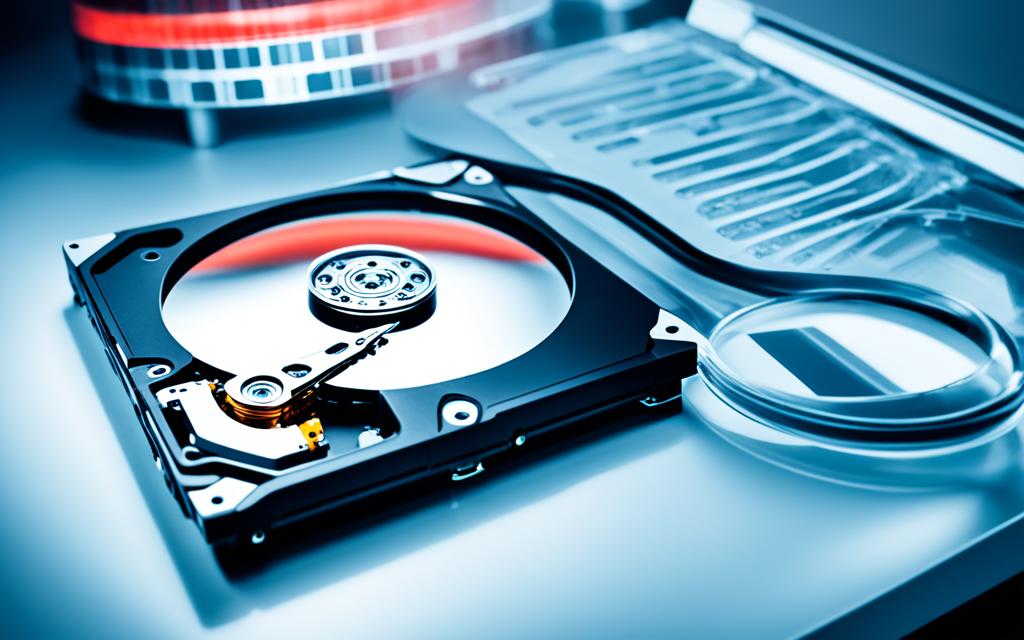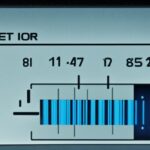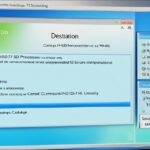Table of Contents
In today’s world, keeping your data safe is more important than ever. It’s essential to check your hard disk drive (HDD) for bad sectors regularly. Bad sectors are damaged areas that can’t store data well. If these are not found early, they can cause big problems for your files. This guide will show you how to check your HDD for bad sectors. We’ll use tools that are built into your computer and some you can get from other companies. Doing these checks helps keep your HDD working well. It also keeps your data secure.
Key Takeaways
- Bad sectors can lead to serious data loss if not managed promptly.
- Regular diagnostics help in detecting bad sectors before they worsen.
- Various tools and commands can assist you in checking and repairing your HDD.
- Data recovery processes are often complicated by undetected bad sectors.
- HDD health can be monitored through SMART tests, aiding early intervention.
To learn more about bad sectors and their impact, refer to this informative guide. It covers diagnostics and recovery options.
For more information on checking computer specifications, visit this resource. It offers valuable insights into system performance.
Understanding Bad Sectors and Their Impact on Your Data
Every hard drive uses thousands of little spaces called sectors to hold data. Bad sectors definition means those sectors that can’t read or save data, stopping them from working right. These problems often come from things like damage, getting too hot, shutting down wrong, or viruses1. It’s crucial for anyone using digital storage to get what causes these issues.
What are Bad Sectors?
Bad sectors turn up as hard ones from physical harm or soft ones due to power cuts or errors in the file system2. Every disk has millions of sectors, and a bad one could mean losing data1. Knowing the difference helps manage your data well.
Signs that Your HDD May Have Bad Sectors
Look out for weird noises from the hard drive, slow access to data, or files getting damaged. These HDD signs of failure need quick action to keep your data safe. For example, if files won’t open or need saving again, it might be a sector problem3. This is why backing up data often is very important.
The Importance of Regular Checking
Doing regular maintenance HDD checks finds issues early, stopping big problems. Tools like Windows’ disk check or others from the internet can find and fix bad sectors. Don’t ignore these signs to avoid losing data. For more tips on checking and fixing bad sectors, see guides on HDD health.
How to Check a HDD for Bad Sectors
It’s important to keep an eye on your hard drive to protect your data. There are several ways to find and fix bad sectors that might cause data loss. Here are two effective methods to check your HDD’s health.
Using the Built-In Error Checking Utility in Windows
Windows has a simple tool for scanning your hard drive4. Just right-click on ‘This PC’ or ‘My Computer’ and choose ‘Properties’. Then, go to the ‘Tools’ tab and click ‘Check’. Make sure to tick both options to repair file system errors and look for bad sectors. This helps prevent losing your data.
Running CHKDSK via Command Prompt
To check for bad sectors in a more detailed way, use the CHKDSK command4. Open Command Prompt and type “chkdsk C: /x /f /r”. Each tag has its role: “/x” takes the drive offline, “/f” repairs errors, and “/r” hunts for bad sectors and tries to save your data4. If it finds issues, you might need to restart your computer. This step helps keep your data safe5.
Setting Up the Error Checking Process
Checking your drive often is a good habit. Always back up vital data before you start5. With both the built-in utility and CHKDSK command, you can look after your HDD’s well-being. Consider exploring more tools like AOMEI Partition Assistant. They can give you a deeper insight into your drive’s condition and S.M.A.R.T. status.
Using Third-Party Tools to Diagnose Bad Sectors
When basic tools aren’t enough, third-party HDD diagnostics come in handy. They offer advanced solutions to find problems. Specialised software spots issues that common utilities often overlook. So, these tools are vital for thorough HDD health checks.
Recommended Tools for HDD Diagnostics
Several tools, like SeaTools, HD Tune, and CrystalDiskInfo, meet different needs in HDD diagnostics. They allow for deep scans, providing detailed insights about the drive’s status. SeaTools is especially good for Seagate and Maxtor drives. It offers tests that check how well your drive is working.
How to Use SeaTools for HDD Checks
SeaTools makes checking your HDD simple. First, download and install it. Then, open the program and choose a test. You can do a quick scan for a general check or a thorough one for more detail. The time it takes varies, from 15 minutes to several hours, based on the HDD’s age and condition.
Advantages of Using External Software
SeaTools and similar programs have many benefits. They can spot different types of bad sectors, which is very reassuring. Their advanced features might even help your HDD last longer by finding problems early. It’s wise to run these checks every six months. Doing so helps avoid data loss. Keeping your HDD in good shape is linked to data safety. Regular checks can save you a lot of money in data recovery later on.
Steps to Repair Bad Sectors on Your HDD
Finding bad sectors on your HDD can worry you, but the right actions can make things better. Knowing what steps to take helps you get back your data more effectively.
Automatic Repairs with Windows Utilities
Windows has tools for auto repairs. Its Error Checking tool fixes small file errors and keeps bad sectors from being used again. This way, you start fixing your HDD without extra software, though some data might not come back6.
If Automatic Repair Fails: Advanced Options
If Windows can’t fix your HDD, you need to look at other methods. Tools like AOMEI Partition Assistant are great at solving hard drive problems, especially bad sectors7. But, using Command Prompt can be tricky and risky. So, trying software like AOMEI or Auslogics BoostSpeed is better if you’re not very technical8.
Conclusion
It’s crucial to check and care for your HDD to keep your data safe and sound. You must look for bad sectors often. Bad sectors can cause permanent data loss. Logical bad sectors mean there might be other problems that need fixing910. By using tools like CHKDSK and others, you can stop issues like system crashes or not being able to get to your data911.
Spending time on HDD care makes it last longer and keeps your important files safe from unexpected losses. It’s important to do regular checks, spot problems early, and use good diagnostic tools1011.
In today’s world, where digital data is super important, looking after your HDD matters a lot for your work and efficiency. By keeping an eye on it and maintaining it regularly, you can trust your storage devices to work well without sudden problems910.
FAQ
What exactly are bad sectors and how do they affect my HDD?
Bad sectors are unreliable areas on a hard disk drive (HDD). They arise from physical wear or software problems. Issues like improper shutdowns can cause them. Unchecked, they lead to significant data loss.
How can I expect if my HDD has bad sectors?
If your HDD has bad sectors, you might see multiple error messages or experience system crashes. Your computer might also slow down or make strange noises. Regular checks and maintenance can help spot these early.
Why is it vital to check my HDD regularly for bad sectors?
Checking your HDD often is key to keeping your data safe. Catching bad sectors early lets you act quickly to prevent data loss. This ensures your storage stays reliable over time.
What built-in tools does Windows have for checking HDD health?
Windows offers an Error Checking utility for HDD health. You can find it by right-clicking ‘This PC’ or ‘My Computer’. It’s designed to find errors and scan for bad sectors, keeping your HDD in good shape.
Can I use third-party tools for diagnosing bad sectors?
Indeed, external tools like SeaTools, HD Tune, and CrystalDiskInfo offer detailed HDD assessments. They give deeper insights and better diagnostic features than Windows’ baseline tools.
What should I do if my HDD has bad sectors?
If your HDD shows bad sectors, running Windows Error Checking might fix them automatically. Should that fail, explore recovery software or get professional help.
Is it possible to recover data from bad sectors?
Sometimes you can salvage data from bad sectors with recovery tools and regular backups. Yet, the best defence is frequent HDD assessments to prevent data loss.
How often should I check my HDD for bad sectors?
You should test your HDD for bad sectors every few months. If your computer starts acting up, check it more often. Regular checks help safeguard your data and extend your HDD’s life.
Source Links
- https://www.easeus.com/knowledge-center/bad-sector.html – What Is Bad Sector? [Bad Sector Explained in 2024]
- https://www.howtogeek.com/173463/bad-sectors-explained-why-hard-drives-get-bad-sectors-and-what-you-can-do-about-it/ – Bad Sectors Explained: Why Hard Drives Get Bad Sectors and What You Can Do About It
- https://superuser.com/questions/1713381/can-bad-sectors-in-hard-drive-really-cause-data-loss – Can bad sectors in hard drive really cause data loss?
- https://superuser.com/questions/1247075/how-do-i-find-bad-sectors-on-my-hdd-when-windows-10-native-programs-apps-service – How do i find bad sectors on my HDD when Windows 10 native programs/apps/services says there are none?
- https://www.diskpart.com/articles/test-bad-sectors-hard-drive-3690.html – How to Test Bad Sectors on Hard Drive or SSD [3 Methods]
- https://www.easeus.com/disk-copy/clone-resource/repair-a-bad-sector-in-windows-10-8-7.html – Repair Bad Sector: How to Fix Bad Sectors on HDD in Windows 10/8/7
- https://www.diskpart.com/articles/how-to-remove-bad-sectors-from-hard-disk-permanently-1881.html – How to Remove Bad Sectors from Hard Disk Permanently
- https://www.auslogics.com/en/articles/how-to-fix-bad-sectors-on-a-hard-drive/ – How to Fix Bad Sectors on a Hard Drive
- https://recoverit.wondershare.com/harddrive-recovery/check-hard-drive-for-bad-sectors.html – How To Check for Bad Sectors on a Hard Drive [3 Ways]
- https://www.easeus.com/partition-master/check-hard-drive-for-bad-sectors.html – How to Check Hard Drive for Bad Sectors – 3 Easy Ways 💡
- https://scotcomp.medium.com/an-introduction-to-bad-sectors-and-their-recovery-4581d7f2745f – An Introduction to Bad Sectors and Their Recovery








